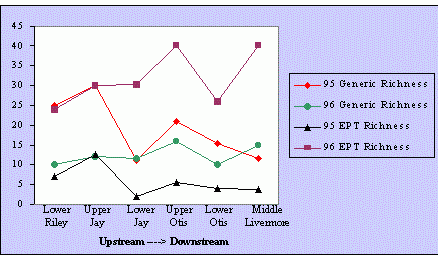Non-attainment in Maine: Problem Identification and Solution
Program Overview
Davies and Tsomides, '97). The standards establish, in narrative form, the characteristics of the aquatic community required for each class. A statistical analysis of the macroinvertebrate data produces a list of probabilities of meeting the criteria for each class; this analysis is supplemented by professional judgement and documented evidence of physical, chemical, and biological conditions (Davies et al, '95).| Class | Biological Standard |
|---|---|
| AA | Habitat natural and free flowing. Aquatic life as naturally occurs. |
| A | Habitat natural. Aquatic life as naturally occurs. |
| B | Habitat unimpaired. Ambient water quality sufficient to support life stages of all indigenous species. Only non-detrimental changes in community composition allowed. |
| C | Ambient water quality sufficient to support life stages of all indigenous fish species. Change in community composition may occur, but structure and function of community must be maintained |
Uses of bioassessment data in Maine include monitoring and assessment, status and trends reporting (305(b) reports), Total Maximum Daily Load evaluations (303(d) listings), support for National Pollutant Discharge Elimination System permitting, watershed assessments, enforcement and litigation support, habitat modification evaluation for hydropower licensing, 401 certifications and 404 permitting, prioritizing nonpoint source investigations, and evaluation of hazardous waste sites. The case study presented below provides an example of the use of bioassessment data in Federal Energy Regulatory Commission (FERC) relicensing, National Environmental Policy Act (NEPA) review, and water quality certification by local, as well as state, governments. This case study demonstrates how biological data have been useful in pinpointing the causes of non-attainment and in elucidating potential solutions.
The Androscoggin River Story
Four impoundments (flowing downstream from Riley through Jay, Otis, and then Livermore) on the Androscoggin River are managed pursuant to two separate hydroelectric facilities, one owned by International Paper Company (IP) and the other owned by Otis Hydroelectric Company (OHC). Bioassessment information was required as part of the FERC relicensing process as well as to obtain a water quality (401) certification from the town of Jay, Maine and the DEP. IP took a proactive approach to the permit process, initiating and coordinating a collaborative effort that involved a number of stakeholders, including OHC, FERC, DEP, U.S. Fish & Wildlife Service, State Planning Commission, Conservation Law Foundation, Atlantic Salmon Federation, and Trout Unlimited.
Selected macroinvertebrate community measures in the Androscoggin River, 1995, 1996 (Adapted from Leeper, 1995; 1997).

A study conducted in 1995 indicated that the benthic communities in the Riley impoundment and the upstream portion of the Jay impoundment were healthy and the water quality met or exceeded Class C. (Class C standard: "Ambient water quality sufficient to support life stages of all indigenous fish species. Changes in community composition may occur, but structure and function of community must be maintained.") However, the results of sampling performed in the lower Jay as well as the Otis and Livermore impoundments, both downstream of the IP treatment plant discharge, indicated that these areas did not meet Class C standards. The primary indicators of non-attainment were low total abundance and a community dominated by stress-tolerant worms and snails. During the biosurvey, fine sediment (a one- to two-inch layer of floc) was observed covering the substrate of the Otis and Livermore impoundments; this destruction of habitat, coupled with the lake-like character of the impoundments, which further enhanced the settling of the floc, was identified as the probable reason for non-attainment.
In 1996, the IP plant experimented with the use of polymers in the wastewater treatment plant to improve the settling of the effluent solids and reduce the amount of solids discharged to the river. The effect of this measure, as well as other possible factors, upon macroinvertebrates was investigated by placing five artificial substrate samplers at each of seven sample sites. After 4 and 8 weeks, the samplers were retrieved for analysis of community structure and function parameters. River flow, dissolved oxygen, and the presence, depth, and condition of the floc were also measured.
The biological results indicated significant improvement over 1995, with healthy communities marked by the presence of sensitive taxa. All sites sampled met the standards for Class C, with five sites meeting Class B. Minimal floc was present, attributable to a combination of very high flows relative to the previous year ,as well as reductions in solids at the IP plant. The identified management strategies included controlled releases from the Riley impoundment, effluent solids reductions, or other measures that may be necessary during extended periods of low flow to prevent solids accumulations and maintain conditions for healthy macroinvertebrate communities. Requirements of the new license include ongoing evaluation and monitoring of conditions.
Lesson Learned
Bioassessment, along with other data, allowed identification of the cause of non-attainment and elucidated management actions necessary to ensure future attainment of water quality standards.
Additional Information
Contact: Susan Davies (susan.p.davies@state.me.us) at Maine DEP (207-287-7778) or visit the Maine website. Exit
References
Davies, S.P., L. Tsomides, 1997. Methods for Biological Sampling and Analysis of Maine's Inland Waters. Maine Department of Environmental Protection. Augusta, ME. 29 pgs.
Davies, S.P., L. Tsomides, D. Courtemanch, and F. Drummond, 1995. Maine Biological Monitoring and Biocriteria Development Program. Maine Department of Environmental Protection. Augusta, ME. 61 pgs.
Davies, S.P., L. Tsomides, J. DiFranco, and D. Courtemanch, 1999. Biomonitoring Retrospective: 15 Year Summary for Maine Rivers and Streams. Maine Department of Environmental Protection. Augusta, ME. 190 pgs.
Leeper, P.C., 1995. Draft Aquatic Macroinvertebrate Study of the Riley-Jay-Livermore Project (FERC No. 2375) and the Otis Hydroelectric Project (FERC No. 8277) on the Androscoggin River, ME. Report submitted by Eco-Analysts, Inc. to Kleinschmidt Associates.
Leeper, P.C., 1997. Phase II aquatic macroinvertebrate study of the Riley-Jay-Livermore Project (FERC No. 2375) and the Otis Hydroelectric Project (FERC No. 8277) on the Androscoggin River, ME. Report submitted by Eco-Analysts, Inc. to International Paper Androscoggin Mill.
